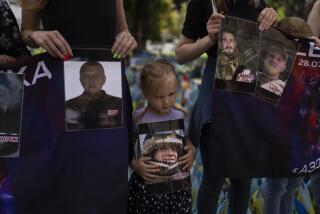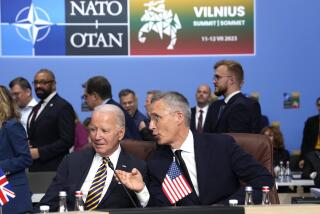Questions Surface Over NATO’s Revised Take on the War in Kosovo
- Share via
WASHINGTON — To hear some of the generals talk today, the Kosovo Liberation Army and NATO could scarcely have worked more closely during the alliance’s 78-day air war in Kosovo.
KLA guerrillas constantly were on the phone to NATO “to tell us there were 15 bad guys down the road,” U.S. Air Force Lt. Gen. Michael C. Short, North Atlantic Treaty Organization air operations boss, told a conference in Virginia last month. And NATO itself “instigated” the KLA’s biggest offensive of the war in May 1999, German Gen. Klaus Naumann, former head of the NATO military committee, told an interviewer.
This collaboration might not be noteworthy--except that NATO leaders so emphatically denied it during the war. And the revisionist accounts are but one example of the way the official accounts have been rewritten or contradicted by insiders since the war.
While the air war is history, the issue is not just academic: The alliance can’t afford widespread doubts about its conduct of the war as it struggles to continue a peacekeeping effort that is likely to drag on for years in the province.
During the conflict, officials of NATO countries said that as many as 700,000 of Kosovo’s 1.9 million people had been internally displaced. Now, NATO officially puts the figure at 500,000, and sources within the alliance acknowledge that it could be much smaller--perhaps fewer than 100,000.
Likewise, during the war, U.S. officials said “tens of thousands” of Albanian men might have been slaughtered by the Serbs. Now, the official estimate is a maximum of 10,000 killed. A number of analysts believe the figure is 6,000 or fewer.
There also has been a reduction in official estimates of how much Serb military equipment was destroyed.
On May 23, 1999, even before NATO had begun the final crescendo of bombing that did most of the damage, President Clinton claimed alliance warplanes had damaged or destroyed one-third of the 1,100 Serb armored vehicles believed to be in Kosovo. When the war ended two weeks later, Defense Secretary William S. Cohen declared that NATO warplanes had “severely crippled” the Serbs’ Third Army, which was deployed to the province.
But official estimates of the damage began falling soon thereafter.
Three months after the air campaign ended, officials said the number of destroyed tanks was 93, rather than the 120 that had been previously estimated. Last month, the Air Force acknowledged that, in a postwar site visit, they had been able to find physical evidence of damage to only 26.
Air Force officials insisted that evidence from other sources--such as witness accounts and satellite pictures--indicated that 93 were struck. But one military officer who had reviewed the evidence said that assertion was “a real stretch.”
Gen. Michael Jackson, the British commander in Kosovo, acknowledged to a parliamentary committee last month: “It’s a matter of record that the actual damage in Kosovo was rather less than the estimated damage.”
The former commanders have let slip other details that contradict the presentation of information during the war.
Short, who retires this month, said that after the embarrassing bombing of the Chinese Embassy in Belgrade, NATO ruled out strikes in the center of the Yugoslav and Serbian capital.
Short said that although “there were political and military targets I’d have gone after,” NATO leaders “had a circle drawn around downtown Belgrade, within which we couldn’t hit anymore.” This prohibition effectively gave the Serbian leadership an area within which it could safely operate, he told PBS’ “Frontline” program.
Short declined a request for an interview for this report.
With all of these examples, allied officials have insisted that they never intended to deceive, and revised their estimates as soon as they learned of inaccuracies.
Jamie Shea, NATO’s chief spokesman during the war, asserted last month that NATO set “a new standard for transparency” during the war. Its briefings provided “more complete and accurate information” than were made available in any previous conflict.
NATO contends that, while its damage estimate was cut back, the downward adjustment was far smaller than in previous wars.
In past wars, battle damage was “sometimes overstated by three or four times,” said Mark Laity, a deputy NATO spokesman. He said NATO officials believe that the latest estimates are generally accurate. But officials do not claim that they are perfect, he said, and realize that “there may be military people who are skeptical.”
Despite the recent comments of the generals, Laity strongly denied that NATO collaborated with the KLA. “We didn’t. Full stop,” he said.
Ivo H. Daalder, a former National Security Council aide now at the Washington-based Brookings Institution think tank, said NATO’s statements should be seen in the context of its deep anxiety about maintaining public support for a war it thought would be over in a few days.
Eager to portray the Serbian regime in a bad light, “they always assumed the worst” about the situation inside Kosovo, he said. And in the interest of averting pressure for a ground war, which they feared would sunder the alliance, they drew the most optimistic interpretations of the success of their air campaign, said Daalder, who has just had a book published about the war with analyst Michael E. O’Hanlon.
How much of a price will there be for being wide of the mark?
Lee H. Hamilton, former chairman of the House Foreign Affairs Committee, said he believes that some NATO leaders were guilty of “great manipulation of the news” during the Kosovo war. Yet he said leaders are always tempted to exaggerate the facts, and he doubts there will be much cost to the United States or NATO.
“It’s typical in a democracy to try to achieve immediate policy goals by overstating and overselling,” Hamilton said. But while historians and policy experts might remember, he said, the public’s memory is short.
More to Read
Sign up for Essential California
The most important California stories and recommendations in your inbox every morning.
You may occasionally receive promotional content from the Los Angeles Times.














